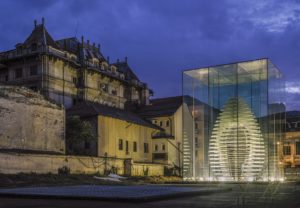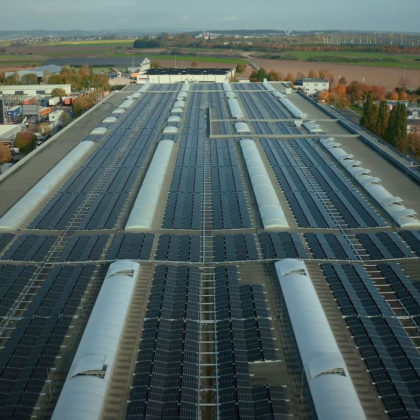Craiova Art Museum honors sculptor with impressive glass art
When works of art from a sculptor are exhibited underground they need an even stronger above-ground anchor point. This is the idea that led to the creation of the twelve-meter-high cube above the new “Brâncuși Museum” in Craiova, which is dedicated to the work of the great Romanian sculptor Constantin Brâncuși. The imposing all glass construction is a tribute to the artist that is visible from afar. With glass panes that are the full height of the building (sedak) the shell is just as impressive as the filigree interior, also made from glass, which is designed to look sculptural and is based on a typical Brâncuși work – the mythical bird Măiastra.
Craiova, the sixth-largest city in Romania (around 260,000 inhabitants), has honored one of its most famous artists, the sculptor Constantin Brâncuși, by adding the “Constantin Brâncuși International Art Center” to the city’s Art Museum. In order to provide extra space for the new exhibition without altering the historic free-standing building, the museum has been extended downwards and given an underground wing.
Above the ground a new work of art has been added: a glass pavilion that bridges the gap between architecture and sculpture, a piece of “op-art” providing an optical illusion consisting of different forms – as is typical for the work of Brâncuși, a glass cube in which an oval, fusiform structure shines and shimmers. The building-art-work is thus also a reference to a project that Brâncuși never realized: the Temple of Indore.
Impressive are the glass panes, each of them twelve by three meters in size, which form the sides of the cube on its quadratic base. Inside, horizontally layered glass lamellae define an ovoid shape reminiscent of the sculpture “Măiastra” in sil€houette, a piece of art created in the sense of Brâncușis work. Here, a completely independent spatial experience awaits the visitor: from the underground level, a glass elevator – transporting only a single person – rises to the centre of the pavilion.
In the few seconds that the journey takes, this person can immerse himself in the world of Brâncuși and experience what the artist wanted to convey through his work: sublimity, peace and the illumination of the mind.
Engineering for art
Twelve façade panes (12.50 x 3.00 m) and three roof panes (9.00 x 3.00 m) form the glass shell, eight glass fins support the façade panes by means of filigree, laminated-in connecting pieces. Within the glass cube, eight further glass fins define the silhouette of the bird “Măiastra” – here with significantly larger dimensions than the original work of art, which was only nine centimeters high: the glass sculpture is larger by a factor of almost 100. In the centre of the construction is the glass elevator. The special shape of the glass panes that form the outline of the bird sculpture was a challenge. And not only in terms of the glass processing. Especially during tempering and lamination, attention had to be paid to the right behavior of the shaped panes in the oven and to the accuracy at the edges.
Constantin Brâncuși: sculptor, artist, cosmopolitan
Constantin Brâncuși (1876 – 1957) was a Romanian-French sculptor and photographer. From 1904 onward he lived in Paris and is regarded as one of the most influential sculptors of the 20th century. His work was not characterized by the realistic representation of objects but rather by reduction, influenced by traditional African and Romanian art. Many of Brâncușis sculptures are egg-shaped heads or flying birds; his works are attributed to the avant-garde in the visual arts. “Măiastra” thereby represents a connection pars pro toto: the representation of birds in almost ovoid shape.
Short interview with architect Dorin Stefan
Brâncuși worked with bronze, marble, wood and plaster. Why have you dedicated a glass pavilion to him and his creations?
The pavilion is not supposed to recreate an object or a particular form from Brâncuși, it is a homage – using the technical and expressive building materials of our time. I am fascinated by glass and its modern possibilities for expression.
What was the biggest challenge in this project?
When I started the project there were not yet any glass panes of more than nine meters – so I planned to have two panes in order to achieve twelve meters in height. Luckily, delays in the project resulted in the advantage that we could use 12.5 meter panes, which by then had become available.
The challenge was in finding a specialist (Wolfgang Kahlert from Germany) to design the statics for such a glass object. At the same time we have a very special elevator that takes us into the center of the glass egg. The elevator is from the Romanian manufacturer ELMAS, which has received international acclaim for it.
What importance does glass have in your architecture?
Of all the different building materials I love glass the most. For me, architecture is defined by transparency and light.
Credits board
Art Museum Craiova, new extension “Brâncuși Art Center”
Architect: Dorin Stefan, Bucharest
Building construction: Manelli SRL
Glass processing: sedak, Gersthofen (D)
Sedak glass:
- 23 triple-pane laminates from low-iron glass, up to 3.00 x 12.5 meters
- 8 glass fins, five-layer laminate, up to 3.00 x 12.45 meters
A unique experience by day and night: the twelve-meter-high glass work of art that is a tribute to the creations of the sculptor Constantin Brâncuși. This art object stands next to the Art Museum in Craiova (Romania). Extended underground, the museum now displays the art of Brâncuși, who came from Craiova.
Pictures: Andrei Pandele
Măiastra, a mythical bird, was a frequent subject of Brâncuși’s sculptures – reduced to a minimalist form and often only a few centimeters high. These in turn served as a template for the impressive large-format glass work of art.
Picture: Dorin Stefan, DSBA
Sketch of the underground extension including the above-ground eye-catcher.
Picture: Dorin Stefan, DSBA
The rendering shows the original building, the Craiova Art Museum, and the glass construction as the new attention-grabber. In this way, the neoclassical building retains its impact despite the increased exhibition space: this was created underground.
Picture: Dorin Stefan, DSBA
For more information please contact:
| sedak GmbH & Co. KG Tatjana Vinkovic Tel.: +49(0)821/2494-823 Fax: +49(0)821/2494-777 E-Mail: tatjana.vinkovic@sedak.com |
|||
Reprint free of charge, copy requested
sedak – leading glass
Since its founding in 2007, Germany-based company sedak has used its pioneering spirit to establish itself as a premium manufacturer of large-format insulated and safety glass. sedak has evolved their glass as a construction material for all-glass facades and roofs. Iconic facades and buildings are created with an unprecedented degree of transparency thanks to superior quality of innovative products.
sedak manufactures single-pane glass units, multi-layer glazing and functional insulated glass units in formats up to 3.6 x 20 meters in an efficient, highly automated system. Raw glass is treated, strengthened, laminated, printed, lamination-curved and assembled into insulated glass with a unique set of machinery that spreads over a production area measuring 35,000qm. Since integrating Italian-based Sunglass Industry srl, who are the specialist in curved glass, sedak’s core expertise also now includes hot bending glass. The specialist also supplies exceptional solutions for luxury yachts with optimized glass for use on the high seas.
The glass fabricator particularly demonstrates its solution-oriented expertise in special designs. Thanks to its research and development spirit, new technologies and the expertise of its 190 employees, sedak is constantly advancing innovations in glass finishing and sees itself as a partner to architects, developers, facade builders and metalwork companies. As a specialist in oversized and extremely heavy glass, the company develops future-oriented solutions to implement customers visions with a flexible approach. The glass fabricator acts as a full-service supplier – from the initial order to final delivery. sedak thus helps advance tomorrow’s visionary architecture today.
Exceptional reference projects provide proof of impressive expertise. These include: Lakhta Center, St. Petersburg / House of European History, Brussels / Faculty of Medicine, Montpellier / Torre Europa, Madrid / Iconsiam, Bangkok / Apple Park, Cupertino / Apple Cube, New York / Experimenta, Heilbronn / Numerous premium flagship stores.
Applications
- glass façades
- glass roofs
- glass stairs
- glass balustrades
- ship building
- safety glazing
- all-glass constructions
- interior design
- custum-made glass units










